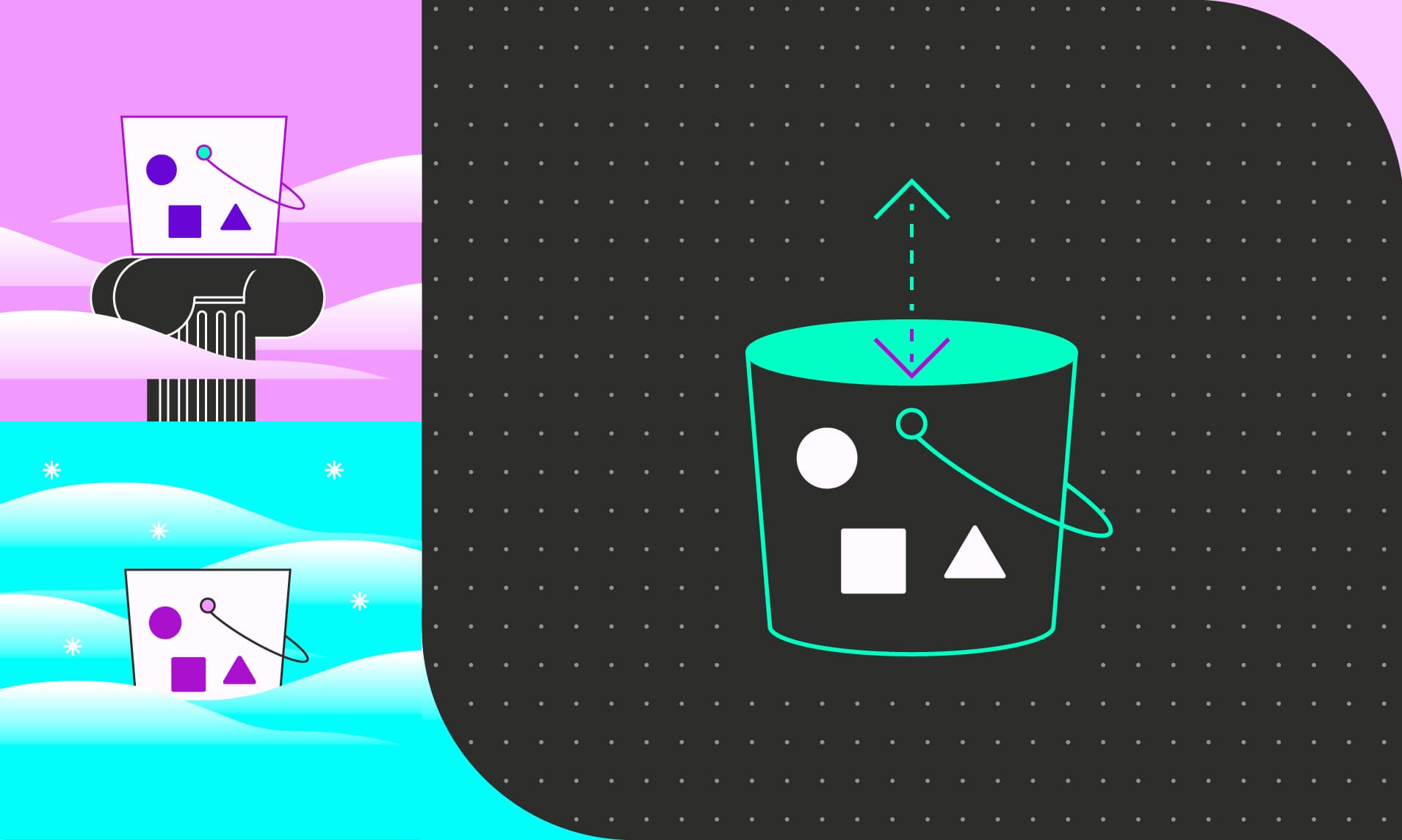S3 Intelligent Tiering Pricing and Potential Cost Savings
Amazon S3 offers a service named S3 Intelligent-Tiering that has the potential to save you money by shifting S3 objects between various S3 storage classes on your behalf. However, there are accompanying fees and use...

TL;DR: Amazon S3 offers a service called S3 Intelligent-Tiering that has the potential to save you money by shifting S3 objects between various S3 storage classes on your behalf. However, there are accompanying fees and use cases where this will actually cost you more money. This post helps break down the mechanics of how S3 Intelligent-Tiering works in simple terms.
Amazon Simple Storage Service (S3) is one of the most popular services that AWS provides and the third highest customer spend on our AWS Cost Leaderboard. AWS has made it dead simple for you to push files (which AWS refers to as objects) up to the cloud into namespaces (which AWS refers to as buckets) that allow you to pay for only what you use. Despite its popularity, S3 is one of the most complicated services from a pricing perspective as it charges you on a variety of dimensions including monitoring costs, the HTTP requests for accessing the service, as well as, the underlying storage utilized. This blog post covers the topic of S3 Intelligent-Tiering which has potentially drastic cost-saving implications for S3 storage in particular, with the ability to save you over 50% depending on your objects' access patterns.
Primer: S3 Storage Classes
Before diving into what S3 Intelligent-Tiering is and how it works, you should be comfortable with understanding the concept that S3 offers various different storage types that can be set on a per-object basis. If you're familiar with S3 storage classes you can skip to the next section.
S3 storage classes cover different use cases, offering varying degrees of durability and access performance, and as a result, different pricing. By default, all objects are stored in the S3 Standard Storage class, which happens to be the second most expensive storage class behind S3 Express One Zone. All other storage classes offer varying, lower levels of durability or access performance.
This post won't go in depth on the various S3 storage classes and how they're priced, but there is a separate blog post where you can learn more about this written here, or you can read brief summaries in the S3 Storage Class section of the Cloud Cost Handbook.
What is S3 Intelligent-Tiering?
S3 Intelligent-Tiering in simplistic terms is an automated service that S3 provides that will monitor access patterns of S3 objects and change their respective storage classes on your behalf to get you automatic cost savings. Objects uploaded or transitioned to S3 Intelligent-Tiering are automatically stored in the Frequent Access tier which has the same pricing as S3 Standard Storage. As objects are transitioned through the tiers the storage cost decreases and the access time increases.
The five storage classes that S3 Intelligent-Tiering transitions objects in between are:
- Frequent Access
- Infrequent Access
- Archive Instant Access
- Archive Access
- Deep Archive Access
Note: Archive Access and Deep Archive Access are not automatically enabled and need to be configured for objects to move to these tiers.
S3 Intelligent-Tiering Cost Savings
Now that you understand the concept of S3 storage classes and what S3 Intelligent-Tiering is, the first question is typically: "How much can this save me?" This question is answered by three key factors:
- How much you have stored in S3 Standard Storage.
- What the access patterns of these objects are.
- How many objects you're monitoring with S3 Intelligent-Tiering.
The easiest way to think about possible savings is by understanding the relative pricing between the five storage classes that S3 Intelligent-Tiering can possibly place your objects in. Below is a table of relative savings percentages to S3 Standard Storage based upon prices in us-east-1:
* Note that Frequent Access has multiple tiers within it ranging from $0.023 to $0.021 per GB month. For simplicity's sake for this blog post, we use the rate for the smallest amount of storage.
Ultimately, only you know your objects' access patterns. If all of your objects are being regularly accessed, you're not going to yield any savings through S3 Intelligent-Tiering. If your access patterns are incredibly seldom then over time you can save over 95% on storage costs by leveraging the Deep Archive Access tier.
The final consideration mentioned above is "How many objects you're monitoring with S3 Intelligent-Tiering." For how that impacts potential cost savings, the entire section below covers this.
S3 Intelligent-Tiering Fees
Monitoring Fees
S3 Intelligent-Tiering has monitoring fees associated with it of $0.0025 per 1,000 objects per month. Note that this fee will occur when you turn on S3 Intelligent-Tiering but it will take time for objects to transition from one storage class to another to realize savings. Ultimately, your savings rate will be impacted by the number of objects that are being monitored by S3 Intelligent-Tiering. To calculate S3 Intelligent-Tiering Monitoring Fees, you can use the following equation (with one example) below:
S3 Intelligent-Tiering Monitoring Costs per Month = # of Objects With S3 Intelligent-Tiering / 1000 Objects * $0.0025
$2.50 per month = 1,000,000 / 1000 * $0.0025
Net Savings Rate
When you think of your possible net savings rate as it relates to S3 Intelligent-Tiering, you should try and gauge how much savings you think you'll yield from having objects transition from one storage class to another. Remember to factor in the monthly fee for the number of objects you'll have S3 Intelligent-Tiering monitor. This can be tricky as S3 Intelligent-Tiering fees are based upon the number of objects monitored whereas the potential savings are derived from the storage of the underlying objects.
If you had 1,000,000 objects that in aggregate were storing roughly 45TB at a total storage cost of about $1,000 per month and you think half of that storage will transition to the Infrequent Access tier (roughly half the cost of the Frequent Access tier), your net savings rates would be about:
Net Savings Rate = (Total Costs Before S3 Intelligent-Tiering - Total Costs After S3 Intelligent-Tiering) - Monthly Tiering Fee
≈$247.5 in monthly savings = ($1000 - $750) - $2.50
S3 Intelligent-Tiering Transition Timelines
Timelines for S3 Intelligent-Tiering transitions are important to take note of as potential savings will be realized over the span of multiple months. It's very likely for your first month of S3 Intelligent-Tiering, your S3 costs will *go up.* Below is a view of these timelines and how long it may take you to realize savings for transitioning objects from one storage class to another.
Additionally, you can configure the optional storage classes for even more savings.
When an object is accessed from the Infrequent Access tier or one of the archive tiers it is automatically moved back to the Frequent Access tier.
Final Considerations
There are a few final considerations to be aware of when it comes to S3 Intelligent-Tiering to level set expectations:
- Depending on object access patterns, you won't save any money. S3 Intelligent-Tiering works by monitoring object access patterns. In the event that your objects are all regularly accessed within 30 days, they will not shift from one storage class to another and you won't realize any savings. In fact, your costs will increase as you'll be paying for the additional monitoring fee for S3 Intelligent-Tiering.
- The number of objects being monitored matters. S3 Intelligent-Tiering charges you by the number of objects being monitored despite your savings coming from storage of objects being shifted from one storage class to another. If you have a large number of objects with a small relative amount of storage the fees of monitoring for S3 Intelligent-Tiering may not make it worth it.
- Intelligent-Tiering Cost Savings Take Time: It's very likely that your first month of S3 costs will go up should you choose to enable S3 Intelligent-Tiering and savings will be realized after multiple months.
Sign up for a free trial.
Get started with tracking your cloud costs.



